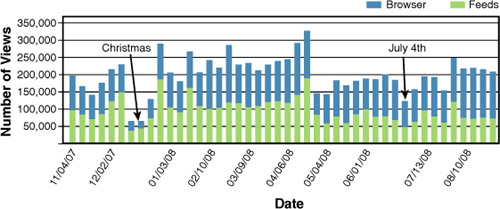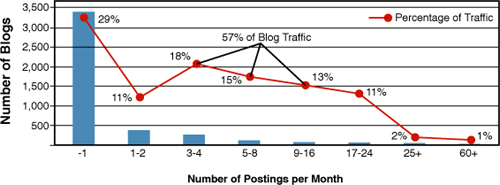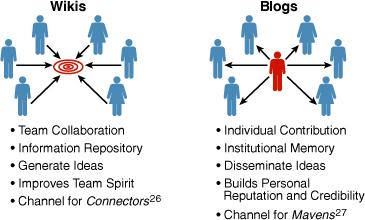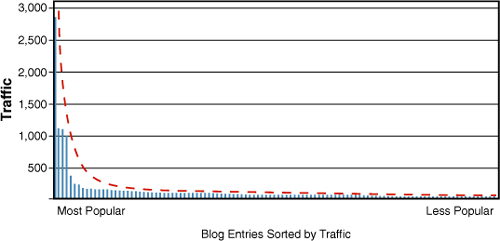In 2002, Ed Brill, an IBM Lotus Notes® product management executive, was facing one of his biggest challenges as a leader in the IBM Lotus Notes and Domino® organization. Unfounded, negative rumors about the future of Lotus Notes were swirling in the marketplace, and traditional marketing and media weren’t effective in debunking the rumors. Ed resorted to a “retail approach,” responding directly by e-mail or in person to individual customers as they raised the rumors with him.[1]
Ed quickly realized he had to find a more efficient way to get the word out, so in December 2002, Ed turned to a relatively new social networking tool: He started a blog.[2] By sharing customer experiences, sales wins, and positive press on his blog, Ed quickly responded to negative rumors. He now had a powerful platform that enabled him to quickly quiet the rumors and transform public opinion, allowing Lotus to go on the offensive and get the word out about Lotus’s positioning and future plans. Ed’s story is just one of countless examples of businesses using social networking tools to improve customer communication and enhance corporate image.
Although fundamentally different from wikis, blogs are another leading Social Age communications tool. Make no mistake—there’s a lot of useless junk on many public blogs. Some blogs become magnets for conspiracy theorists or are not much more than electronic personal diaries. On the other hand, many bloggers who would never be published by a traditional press (or have no interest in being published), still have valuable things to say. These bloggers find ample outlet for their thoughts on the Internet. In many ways, public blogs are a fascinating kaleidoscope of peacefully coexisting thought streams, quietly defending freedom of speech and offering perhaps the ultimate platform for imagination and wit.

By contrast, business bloggers tend to be a bit more serious in their posting. After all, they have a professional reputation to protect or to build. Business bloggers are often technically savvy and considered to be experts in their area of specialization. They enjoy the process of writing as much as the idea of sharing their knowledge with a wider community. In his best-selling book The Tipping Point: How Little Things Can Make a Big Difference, Malcolm Gladwell identifies employees he calls “mavens.”[3] Business mavens are the collectors of information in corporations. Blogs provide the perfect channel for mavens to disseminate their collected information for the benefit of others.
Often, business maven bloggers are unaware that they are contributing to a strong and viable “institutional memory” with their posting. Institutional memory is the “collective know-how, experiences, and bits and pieces of culture held by a…group of people.”[4] Institutional memory traditionally has been preserved via direct contact between more senior business leaders and less experienced employees. But new technologies such as blogs have opened a channel for consistent communication with the business collective, which serves to preserve the ideology and institutional memory of the organization.
Blogs fill a vital role in the Social Age corporation—they provide a previously unavailable, free forum of expression. By definition, traditional business publications such as newsletters, monthly updates, and other printed materials are self-limiting vehicles for expression. Some companies don’t even bother with these publications. For companies that do, articles must be created, submitted, reviewed, and edited before publication. The time that passes while all this takes place might mean that by the publication date, the information is already outdated. The cost of publishing further limits the frequency and length of traditional print publications. Blogs remove these artificial barriers, significantly improving overall business communication.
Another unintended consequence of the limitations of print publications was highlighted in a 2005 article in the Public Library of Science. Dr. John Ioannidis argued that although there are few prestigious scientific journals, an immense and constantly expanding pool of contributors clamor to be published in these few publications. In addition, the top scientific journals tend to select only research papers with the most extraordinary claims, which are often disproved after only a few years. The scarcity of scientific journals has created an increasing concern, as argued by Ioannidis, that most current published research findings in prestigious scientific journals are ultimately proven false.[5]
Similarly, when businesses lack sufficient venues for expression, the result can be “innovation stagnation.” Based on the demographic of a constantly growing worldwide business community, it will soon be impossible—if it is not already—to limit verbal expression to the printed page.
Blogs are effective, egalitarian, and the least costly method to share ideas within a business and across highly technical communities. And business bloggers who venture onto external blogs might unintentionally even provide free advertising and increased mind share for their company or product!
Blogs are among a wide variety of “push” social networking tools. Wikis and forums are by contrast “pull” social tools, encouraging a host of contributors on a particular topic. In the public Internet, blogs and other push social tools proliferate. These tools often integrate technology, social interaction, and the blending of text, pictures, video, and audio. Each social tool is uniquely defined by the varied contributor perspectives and by the creation of shared meaning, as contributors offer the benefit of their stories and experiences.
There’s telecommuting, and then there telecommuting! Luis Suarez Rodriguez is one of those lucky people who had the opportunity to live in the amazingly beautiful Canary Islands, in the southwest of Spain. Luis is also lucky because he works for IBM, supporting a diverse group of customers all around Europe. And what energy! Luis’ enthusiasm is contagious—a conversation with him makes you jump for joy that you might finally have a chance to regain control of your life by using social networking tools.[6] Luis is a full-time “social computing evangelist,” avid blogger, and innovator who is widely recognized for his out-of-the-box thinking. His unique attitude toward e-mail, for example, landed him an article in The New York Times in June 2008.
Luis made a decision in 2008 about e-mail: He was going to change the way he communicated with customers and coworkers. He would only selectively respond to e-mails and would create a blog in which he would document his status along with the resolution of customer issues. Leveraging blog technology to document his work routine was a simple change, but it created enormous business efficiency for Luis. Every time somebody asked him a question, he would post the response or the solution to the problem on his blog, or choose the appropriate social software tool to accommodate that need.
Within just a few months, Luis had effectively slashed the number of e-mails to which he had to respond by 85 percent. No wonder The New York Times gave him room to tell his story!
Using blogs as a communication and collaboration vehicle is a paradigm shift. Sure, you could “cc” a bunch of people with an e-mail, but that just clogs their inboxes. And how many times has an important e-mail fallen to the bottom of your inbox, perhaps never to be seen again? Like Luis maybe you get the same request for information from several people, over an extended period of time. Why repeat the same information over and over when it would be just as easy to post the answer to your blog?
Luis hasn’t done away with e-mail entirely and doesn’t recommend that you do so either. Instead, he reserves the use of e-mail for personal issues or confidential content that can’t be posted openly on his blog. He recommends that when someone asks you for information, it should be posted to your blog. Point the requester to your blog for the answer. This gets them in the habit to look there first for an answer. With a fully indexed, searchable blog, finding information is a snap. The blog is also an excellent place to post documents and make them available to your customers and friends. This strategy eliminates a lot of overhead for both storage and network traffic.
Luis also uses other cool tools such as Google Docs[7] to collaborate with colleagues on document creation and edits. Just as when using the blog to post documents, using collaboration tools for building documents reduces storage, network load, and frustration because the latest version or comments are always available to the community.
When switching to a blog-centric communication paradigm, you also lessen the stress of “mental context switching.” Jumping between various desktop contexts creates an unnecessary but real strain on your mind—a strain that is significantly lessened when communication is consolidated in your blog. Finally, the blogger might think that he or she is merely “pushing” information out to readers, but the blog is actually a two-way street. Bloggers receive value when others comment or make suggestions on difficult problems they have trouble with.
Ironically, while cyber-socializing is exploding in popularity, a similar explosion has taken place in the print publishing world as well, also driven by open collaboration and communication on the Web. A good example of this synergistic transformation is The Open Laboratory, an annual publication of the best science, nature, and medical blogs.[8]
This is a noteworthy case because the publishing paradigm was reversed. Rather than publish a book and support it with a Web site, The Open Laboratory existed as individual blogs before coming together as a printed book.

Dave Ng and Glendon Mellow
Scienceblogs.com first collected a list of the best 50 science blogs, as rated by a community of on-line scientists. The printed anthology of these 50 blogs, titled The Open Laboratory, first appeared in 2006 and was published by Lulu.com. This book was the product of the blogosphere from conception to distribution. It was about blogs, assembled by blogger votes, published by an online publishing company, and promoted through Lulu.com directly to bloggers.
The success of The Open Laboratory was just part of the impressive growth of Lulu.com, and now Lulu.com publishes nearly 100,000 new works each year.[9] Exciting social networking tools on Lulu.com keep authors connected, and Lulu.com leverages their community networks to promote authors’ work. The Open Laboratory demonstrates that a traditional medium can successfully coexist with and complement a Social Age medium.
At the risk of sounding self-serving, printed books are still an excellent medium of communication and not likely to be displaced any time soon. Publishers of printed books who leverage the Web to increase sales are creating new value for themselves and their customers.
Although maintaining a different focus than Lulu.com, Flickr.com[10] also successfully leverages social networking communities. In addition to providing a storage space for member photographs, Flickr.com sustains a thriving community of photography buffs along with the tools they need to edit, organize, and share their pictures. Flickr.com members take pride in sharing pictures, creating a sense of community that encourages strong customer loyalty.
Many new businesses are now carefully integrating social networking into their business models. With such an approach JacketFlap.com[11] is shaking up the world of children’s books. Calling themselves, “…the world’s most comprehensive children’s book resource and social networking Web site for people in the children’s book industry,” JacketFlap showcases more than 3,000 published authors of children’s books. The site is a magnet for the eyes of educators, librarians, agents, and editors. JacketFlap considers itself primarily a social tool for authors and only secondarily a publisher of original work.
In 2007, a team at IBM deployed an enterprise blog service called BlogCentral as a way to stimulate collaboration and to create an alternative channel for information dissemination. Later in 2007, the services were instrumented to track unique browser views and RSS (Really Simple Syndication[13]) feed requests. Six months after BlogCentral opened, the creation of new blogs leveled off and the total number of active blogs topped out at approximately 5,000. The traffic to these blogs continued to grow, however, and by November 2007, the average volume to all blogs was approximately 148,000 users per week.
Hot news drives traffic volume on popular blogs just as it does in traditional news media. BlogCentral network traffic spikes were caused by product announcements or organizational changes that generated a flurry of comments on the blogs. Figure 4.1 shows traffic volumes, with lower volumes during Christmas week vacation, and again on the Fourth of July.
Figure 4.1. IBM weekly blog traffic via browser views and RSS feed retrieval from November 2007 through August 2008.

This study offered some interesting and unexpected findings about IBM blog traffic. Originally, we thought that the more frequently a blog was updated, the more traffic it would generate. After analyzing the data, however, we discovered to our surprise that frequent updates to a blog didn’t necessarily generate additional traffic. Instead, blogs that were updated between four times a week and twice a month generated more than 57 percent of total blog traffic.
Rather than a frequently updated blog, a successful blog was one that included clear writing, an interesting topic, and regular weekly updates—daily updates didn’t generate any significant additional traffic to the blog. Among our top 5,000 blogs by activity, the majority are updated less than once a month. BlogCentral demonstrates that quality counts in a business blog much more than frequent updates.
Figure 4.2 shows the number of most active blogs compared with the update frequency. The percentage line shows, by blog category, the traffic generated.
Figure 4.2. IBM blog update frequency and traffic they generate after a new posting, March 2008 through August 2008.

The traffic generated by BlogCentral followed a “long-tail”[14] typical of other social tools (Figure 4.3). The long tail is caused by the large number of user accessing only a few blogs and a large numbers of blogs viewed by a much smaller number of users.
BlogCentral is a worldwide phenomenon at IBM, as illustrated by the business region distribution in Figure 4.4. Combined globalization and increased economic pressures were instrumental in worldwide adoption because all regions had equal access to the technology. Little if any local resources were required to take advantage of BlogCentral from any IBM office worldwide. Feedback on the effectiveness of blogs and efficiency gains were likewise not limited to any region. Globally distributed satisfaction surveys were analyzed by region, providing strong quantified evidence that internal blogs generate great value throughout a global environment.
Ed Brill’s blog success, mentioned at the beginning of this chapter, had many other positive consequences beyond just quieting unfounded rumors about the Lotus product. His blog continues to positively impact Ed, the Lotus community, and the Lotus brand. Ed proudly notes that Lotus Notes and Domino have had 16 consecutive quarters of growth. He doesn’t attribute all this success to his blog, of course; but by providing a unifying platform for the Lotus community, it definitely contributes to the success.
Although not a company-sponsored IBM blog, Ed’s blog provides a face to the Lotus brand with which the community can interact. The blog covers a wide variety of topics relevant to Lotus customers. The posts might be around product announcements, upcoming events, or media coverage of Domino. As important as these business topics can be, people still crave the human touch in their interaction with corporations. Ed’s blog bridges the gap perfectly between his corporate and personal persona. He says that because this has always been a personal blog, he includes much more personal information than he would have if it were an IBM-sponsored blog. Ed has blogged about a host of personal issues, from his difficulties obtaining a Brazilian visa, to a review of the restaurant where he had an anniversary dinner with his wife.
Readers might go to Ed’s blog to learn more about Lotus, but end up personally getting to know Ed Brill, the man behind the blog. They find out Ed is not just an IBM director but is also the regular guy from Chicago who blogs all about his worldwide travel adventures. As any good salesman will tell you, people buy from other people. Getting to know the people personally with whom you do business helps build trust and loyalty. Blogs create a magical balance when personal stories get intertwined with valuable business content.
Wordpress.org, Blogger, and TypePad are some of the more popular hosted blog sites, in which anyone can create a blog on any given topic.[15] These sites share some common characteristics:
• Free—No cost to create and host your blog on these sites.
• Comments—Ability to interact with your audience. Comments can be turned on or off for the site or individual blog posts. Comments can also be moderated, requiring author’s approval before being publicly viewable.
• Profile—Blog authors create a profile page that describes their background, interests, and expertise.
• Access controls—Determine who can see certain posts.
• Customization—Ability for a blogger to choose from a wide variety of ready-made themes to personalize the appearance of the blog. Themes control font, colors, and layout. They can provide a mood for your site—corporate, playful, informative, or zany, depending on the purpose intended for the blog.
• Widgets—Increase the usefulness of your reader’s experience by including widgets or drag-and-drop elements. These can include elements internal to your blog such as search, blog archives, or recent comments. You can also include external feed elements such as Twitter, Flickr, or social bookmarking.[16] (Amazon.com provides easy-to-use widgets that might get you some easy income by linking your blog readers to the Amazon.com retail site.)
• Embedded authoring tools—These sites provide their own embedded authoring tool for writing your posts. They provide rich text and photo import abilities and basic formatting controls.
The embedded authoring tools described previously are sufficient if you publish one blog or if formatting requirements aren’t complicated. If you post to multiple blogs, (for example, inside and outside of the corporate firewall), or if you have sophisticated formatting needs that aren’t met by the embedded authoring tools, a blogging client is probably called for.
Blogging clients also provide
• Blogging while disconnected—Save an entry you’ve written offline until you’re connected and ready to publish.
• Saving blog entries—Blogging clients enable you to save your work in draft mode. When your post is published, a copy is saved in your client. Publishing the post on a different blog at a later date is easily done. This feature also provides portability of your content if you delete your blog or switch blogging accounts.
• WYSIWYG editing—Type just as you do with word processing software. No HTML or other coding required.
Popular blogging clients have a few unique features to consider:
• BlogJet—Rich feature set and also the most expensive of this list.[17]
• Ecto—A native Mac OS X application, offering a more powerful and easier-to-use editing interface than the built-in control panel of your blog.[18]
• Windows® Live Writer[19]—Part of Windows Live, Writer makes sharing your photos and videos on almost any blog service straightforward. Publish digital media to Windows Live, Wordpress, Blogger, Live Journal, TypePad, and many more[20] (only available for Windows® platforms).
• Qumana[21]—Make money from your blog posts. Use it to insert keyword ads in one click. Exercise choice and control over the ads in your blog posts.
• ScribeFire[22]—ScribeFire Blog Editor enables you to easily drag-and-drop formatted text from the Web into your blog, post entries, take notes, and optimize ad inventory directly through the Firefox browser.
Consider how your company blog or your employees’ blogs can provide value to your customers. Companies commonly use blogs to share ideas on upcoming products, at the same time enabling some level of interaction with consumers. Some companies have encouraged employees to blog externally, on behalf of the company, as a way to engage with individuals in cyberspace. When considering blogging for your company, determine if blogging provides value beyond existing formal communication channels. Blogging is a helpful tool if it advances your business or helps set the tone for the business.
Inside a company, blogging can play a variety of roles and offer a host of benefits. With a blog, employees can share their work with a broader population. Strong collaboration starts with common understanding, using a common language and conceptual framework. Individual or team impact increases the more broadly this information is disseminated. Blogs enable distant employees and associates who most likely will never meet in person to create a bond and business relationship that is invaluable for the business. We live in a smaller world, and the more connections and relationships we have, the more business opportunities we can enjoy. As with wikis, with blogging tacit knowledge is more easily shared. The discipline of writing also forces people to articulate their thoughts and activities in a way that teaches others, strengthening communication skills at the same time. Finally, blogging personalizes the workplace in a meaningful way. The closer you feel to colleagues and associates, the more capacity you can develop to handle stress. In essence, wikis and blogs play a subtle but important part in decreasing stress in the workforce by lowering communication barriers and building relationships, even with colleagues in distant parts of the company.
Typically businesses are concerned that if employees are communicating freely with social networking, they might violate social taboos or business protocols. This is an understandable fear, but the powerful benefits of enabling this interaction greatly outweigh the potential harm. (A well-thought-out and carefully communicated blog governance policy can help mitigate any concern in this area.) Blogging helps employees feel more connected and is an excellent way to bridge the greater global divides and empower geographically dispersed employees with a common mission.
Commercial blogging tools include external hosted tools such as Blogger, Live Journal, and Lotus Connection Blogs.[23] Open source counterparts include Wordpress and Drupal.[24]
Commercial offerings make it easy to host many blogs on the same service. Lotus Connection Blogs for example, can enable tens of thousands of blogs, allowing a large company to create a vibrant community. Businesses might consider how integrated they want the blogging community to be within the company. Is there going to be a need for an integrated search covering all the blogs? Will the blogging be focused internally or externally? How does the blogging activity support the mission of the business? All these questions have a bearing on the blogging tool ultimately selected.
Commercial offerings allow for a single installation that provides multiple hosting solutions. Products such as Lotus Connection Blogs enable a company to internally deploy and enable the workforce with an integrated set of tools. With little technical knowledge, employees can create blogs around specific topics or publish their thoughts on day-to-day activities. Open source counterparts can enable a similar solution but would require more work. Solutions such as Drupal are the likely best fit, enabling similar blog creation management with lightweight installation. Although not as mature or feature-rich as some commercial counterparts, several open-source alternatives can be considered solid blog platforms.
IBM’s experience confirmed that social behavior associated with blogs and wikis is remarkably different. Corporate blogs “push” information out to a large constituency of passive readers and generate new content from few sources. Corporate wikis, on the other hand, “pull” information from a diverse set of employees collaborating with each other and draw mutual benefit from the interaction and content contribution. Wikis and blogs are, therefore, distinctly different in traffic volumes and network patterns. At IBM, wikis have 30 times more traffic than blogs.
Because of these differences, the IT demands of wiki technology and those of blog technology are also significantly different. High traffic levels on effective corporate wikis require significantly more IT capacity than most blogs. The resource-hungry, middle-pack wikis discussed in Chapter 3, “Wikis: Bringing the Crowds to You,” benefit from dynamic provisioning of software and hardware, which is provided most effectively on highly virtualized servers leveraging cloud computing. (In Chapter 6, “Cloud Computing Paradigm,” we explore cloud computing in detail.)
Without careful planning, the heavier demands of wiki traffic can strain your IT infrastructure and your IT team. Successful business transformation using wikis requires exceptional system response time and reliability. The wiki community needs to experience good performance and feel the tool can be trusted. Poor performance or a cumbersome interface can discourage users, and the business benefit of the wiki can quickly be lost.
There are several options for businesses to establish a companywide wiki service: Build it in-house (self-hosted); buy it (outsource the hosting); or rent it. (Many SaaS[25] vendors offer wiki services.) Regardless of the option chosen, the business should maintain control over the taxonomy and overall data on the wiki. That is to say, the basic structure and naming conventions of wikis should be the same across your company. Be sure users feel at home the first time they venture onto any company-hosted wiki.
Some organizations create groups of social networking ambassadors who act as evangelists, promoting the capabilities of the tools through their own use of them and encouraging the participation of others. IBM and some IBM customers have encouraged participation with the use of “merit badges,” given to users who attain a new skill or achievement in social tool use. Merit badges might be given, for example, for the first 10 wiki contributions, the first 100 bookmarks, or the first blog created. The badges can be glyphs displayed within the social tools or on e-mail footers.
Social tools will not be embraced by everyone, no matter your adoption strategy. But you need only a subset of your organization to be active, and everyone else can still benefit. If only 10 percent of an organization is tagging information, it can still improve Search for the entire population.
The model Rheinmetall adopted, as mentioned in Chapter 2, “Social Age Organizations,” in which tool preferences were offered for several generations of workers in a single portal, might be a good solution as social networking is rolled out in your organization. Sometimes older employees adopt social networking tools more slowly than Generation X or Millenials. Even if these older employees do not contribute directly to the social tools, however, other employees can still benefit from their work experience. For example, a social tool user might communicate with one of the older employees and receive information via e-mail or instant messaging. These communications can be tagged by the social tool user and then contributed to the social systems. This method enables workers with different work styles to effectively interact, while at the same time capturing knowledge in a reusable form for the benefit of all.
As we close this chapter on blogs and other “push” tools, keep in mind that in some ways, blogs create something of an oligopoly, in which most of the production (in this case information content creation) is driven by a few key bloggers. Intentionally or not, these few blogs can set or redefine the culture and pace of the company. Just as in the case of public blogs, business blogs follow a long-tail pattern characteristic of social tools. That is to say, on a graph of usage, only a few blogs (the oligopolists) account for most of the traffic. The rest of the traffic forms a long, flat tail. (Figure 4.3, BlogCentral, shown earlier in this chapter, is an example of the long tail.) With this in mind, be sure to create a corporate governance for blogs and for wikis to maintain an environment that supports corporate goals and to set expectations about what is acceptable.
In Part II, “Social Networks,” we provide important guidance about the significant implications of the Social Age for an organization’s overall infrastructure and priorities. Deploying Social Age technology without proper planning and support can lead to unnecessary and unexpected challenges.
• Blogs are fundamentally different from wikis, which “pull” information from the community. Blogs “push” information and provide an important medium for information dissemination not available in traditional print media.

[26]
[27]
• Wikis and Blogs each play different roles in the enterprise and leverage specific contributor skills.
• Blogs follow the classic long-tail demand curve because only a few blogs generate most of the traffic.
• Different traffic patterns on blogs and wikis respectively require careful IT planning before implementation.
[26] Malcolm Gladwell, in The Tipping Point, How Little Things Can Make a Big Difference (New York: Little, Brown and Company 2000), 38 and 41, defines Connectors as people who, “link us up with the world...people with a truly extraordinary knack of making friends and acquaintances.”
[27] Malcolm Gladwell, in The Tipping Point: How Little Things Can Make a Big Difference (New York: Little, Brown and Company 2000), 34, 62, 64-71, quoting Linda Price, marketing professor at the University of Nebraska: “A Maven is a person who has information on a lot of different products or prices or places...they like to be helpers in the marketplace.”


